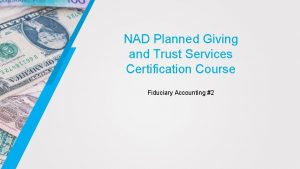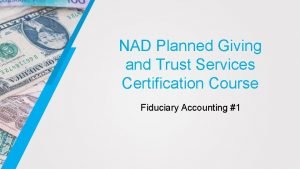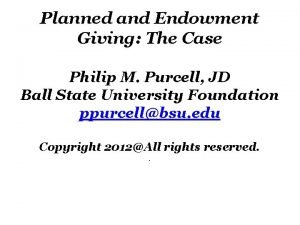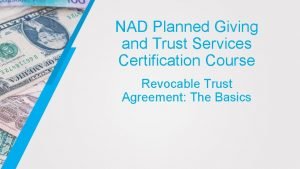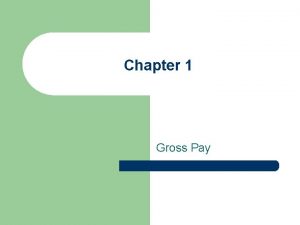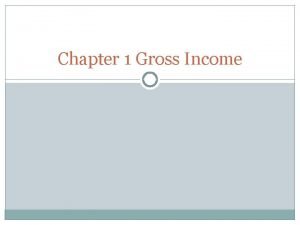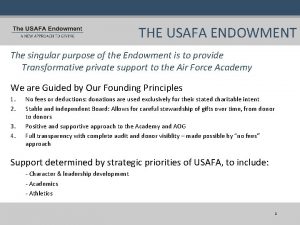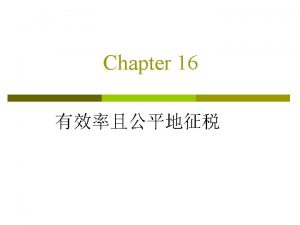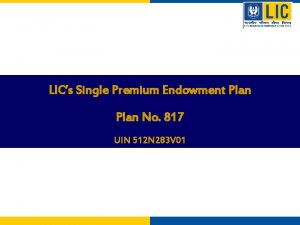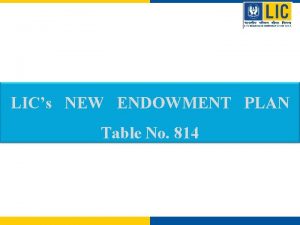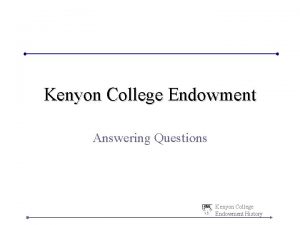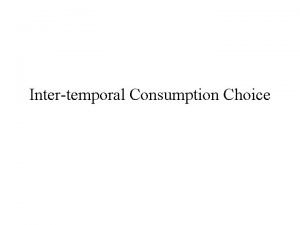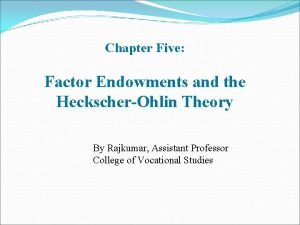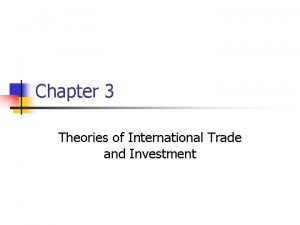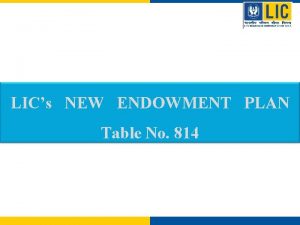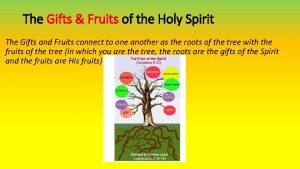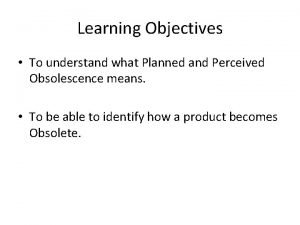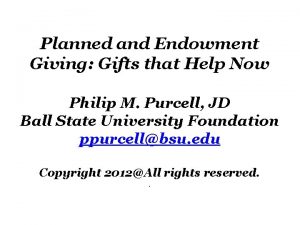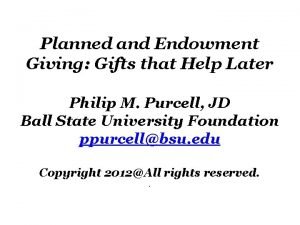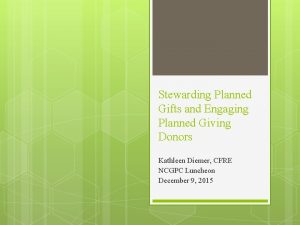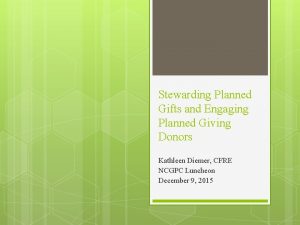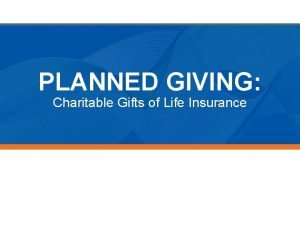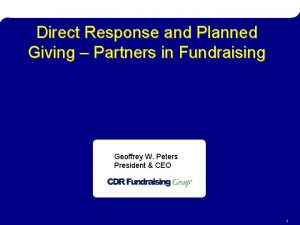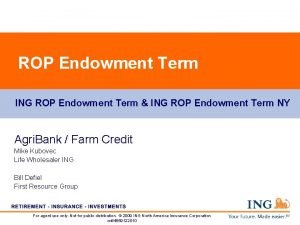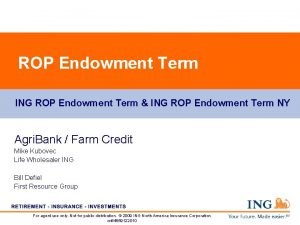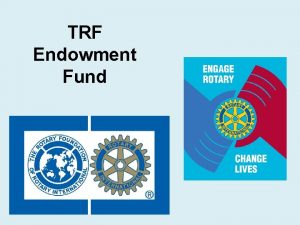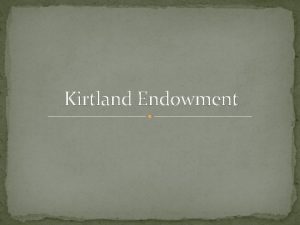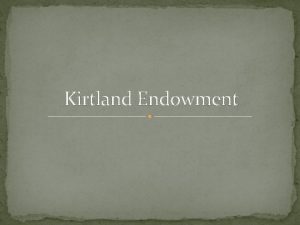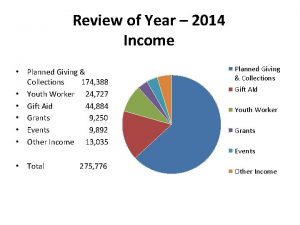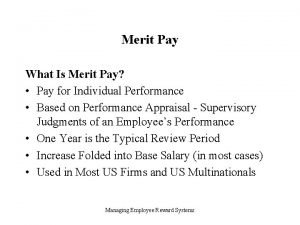Planned and Endowment Giving Gifts that Pay Income















































- Slides: 47

Planned and Endowment Giving: Gifts that Pay Income Philip M. Purcell, JD Ball State University Foundation ppurcell@bsu. edu Copyright 2012@All rights reserved. .

Planned Gifts that Pay Income or Provide Life Estate • Charitable Gift Annuities • Charitable Remainder Trusts • Pooled Income Funds • Remainder Interest in Personal Residence or Farm with Retained Life Estate 2

Partial Interest Rule • No charitable income tax deduction for gifts of a partial interest in donated property. • No deduction for a gift in which the financial interest in the donated asset is split between the donor (or others) and a charitable organization. • Exceptions allowed for specific types of “split interest” gifts.

Qualified Split Interest Gifts • Charitable Lead Trust • Charitable Gift Annuity • Charitable Remainder Trust • Pooled Income Fund • Remainder Interest in Personal Residence or Farm with Retained Life Estate

Present Value • Lead Trust: Gift tax reduced by present value of income payments projected to charity over term of lead trust per IRS formula. • Gift Annuity, Charitable Remainder Trust, Pooled Income Fund, Remainder Interest: Income tax charitable deduction for present value of charity’s future interest per IRS formula.

Charitable Gift Annuity 6

What is a Charitable Gift Annuity? • A gift annuity is a contract between a donor and charity. • The donor contributes cash or assets. • The charity promises to pay a lifetime income to the donor or loved ones chosen by the donor. • 1 or 2 annuitants per contract. 7

Key Definitions • Donor: Contributes cash or assets. • Payments: Made by charity to one or two annuitants per gift annuity contract. • Rates: Payments based on rates recommended by American Council on Gift Annuities. • Annuitant: Donor/others who receive payments. • Residuum: Amount remaining when the final annuitant dies. 8

How a Charitable Gift Annuity Works 1. GIFT 2. INCOME 3. RESIDUUM Donors When annuitant(s) die, the residuum is available for charity’s use. 9

Recommended Rates • ACGA formed in 1927. • Rates at www. acga-web. org. • Rates are voluntary. • Rates are subject to change. • Reasonable assumptions to assure a valuable residuum. • Avoids competition. 10

Assumptions of ACGA Rates 1. 50% of the initial gift remains at annuitant’s death. 2. Invested assets earn 5. 5%. 3. Fees of 1%. 4. Projected life expectancy based on standard mortality tables. 11

Corporate Liability • The obligation to make the annual payments is a corporate obligation. • Be certain that donated assets can be sold! • Residuum not guaranteed. • Financial Statement: Payments are a liability. • Financial Statement: Gifts are an asset. 12

State Regulations • Must comply with applicable state laws where the donor resides • States may regulate: rates, contract language, reserve requirement, investment restrictions • Details for all regulating states at ACGA website: www. acga-web. org

Immediate Payment Charitable Gift Annuity 14

One Life Immediate Payment Rates Age Rate 60 4. 4% 70 5. 1% 80 6. 8% 90+ 9. 0% (ACGA rates as of January 1, 2012) 15

Sample Two Life Immediate Rates Younger Age / Older Age 60/65 70 / 75 80 / 85 Rate 4. 0% 4. 8% 6. 1% (ACGA rates as of January 1, 2012) 16

Example of an Immediate Gift Annuity Mary Smith Age 70 Contributes $50, 000 Annuity rate is 5. 1% or $2, 550 annually 1. If fund earns as expected and 2. If Mary dies as predicted then ü$25, 000 residuum to charity 17

Risk of Gift Annuity Obligations If Mary dies sooner, then charity may receive more than a 50% residuum. But… If Mary outlives her expected life expectancy, then charity must continue her annuity payments. 18

Immediate Payment Gift Annuity $50, 000 $2, 550 70 Year Old Donor 5. 1% Payout (Rates as of January 1, 2012) 19

Immediate Payment Gift Annuity Income Tax deduction = $16, 769 $50, 000 $2, 550 70 Year Old Donor 5. 1% Payout $2, 091 Tax Free Effective Payout Rate = 8. 3% 20

Can Be Established During Life or at Death During Life • Also called “inter vivos”. • Most charities require a minimum of $5, 000$10, 000 for first annuity. • Pays income immediately. • Current income tax charitable deduction. At Death • Also called “testamentary”. • Included in will. • Pays income to surviving loved ones. • Estate tax charitable deduction. 21

Benefits of Gift Annuity for Donor 1. Fixed payments for lifetime at attractive rates. 2. Current income tax charitable deduction. 3. A portion of payments is tax-free. Cash gifts increase tax-free payments. 4. If capital gain property such as stock is donated, then portion of payments taxed at capital gain rate. 5. Note: If anyone other than donor or spouse receives payments, then capital gains tax is immediately owed plus potential gift tax. 6. Donation removed from taxable estate. 22

Deferred Payment Charitable Gift Annuity 23

Deferred Payment Gift Annuity • Donor elects to delay receiving income for a set period of time. • Results in a higher annual payout rate once payments begin. 24

Sample One Life Deferred Payment Gift Annuity Rates Age 50 Rate (10 Years) 5. 31% Rate (20 Years) 9. 2% (as of January 1, 2012) 25

Example of Deferred Gift Annuity Bob Boomer Age 50 Contributes $50, 000 for deferred annuity that will begin payment in 20 years during his retirement at age 70. Annuity rate is 9. 2% or $4, 600 annually 1. If fund earns as expected and 2. If Bob dies as predicted then ü$25, 000 residuum to Charity 26

Benefits of Deferred Payment Gift Annuity for Donor 1. Fixed deferred payments at attractive rates beginning at designated date for rest of lifetime. 2. Current income tax charitable deduction. 3. A portion of payments is tax-free. 4. If capital gain property such as stock is donated, then portion of payments taxed at capital gain rate. 5. Note: If anyone other than donor or spouse receives payments, then gift tax may be owed. 6. Donation removed from taxable estate. 27

Profile of Donor • Desires fixed income for self and/or loved ones. • Attractive rates for older donors or those willing to defer income. • Needs tax savings. • Desires tax-free payments. • Can start with smaller gifts and donate for more and larger annuities over time. 28

Charitable Remainder Trusts 29

Charitable Remainder Trusts Future Interest Gift TRUST Income Donors Charity Income to donors or individuals named by donors 30

Can Be Established During Life or at Death During Life • Also called “inter vivos”. • Commonly at least $100, 000 initial gift. • Pays income immediately. • Current income tax charitable deduction. At Death • Also called “testamentary”. • Included in will. • Pays income to surviving loved ones. • Estate tax charitable deduction. 31

Charitable Remainder Trust Income Tax deduction = $50, 607 $100, 000 $5, 000 69 Year Old Donor 5. 0% Payout CHARITABLE REMAINDER TRUST Payout increases or decreases with value of trust 32

Benefits to Donors 1. Income paid to the donor and/or loved ones for lifetime(s) or term of years (not to exceed 20 years). 2. Charitable tax deduction. 3. Escape of capital gains tax. 4. Personalized investment portfolio can be adjusted over time as needs change. 5. Donor selects trustee to manage the trust. 6. Trust assets excluded from estate tax. 7. Flexibility to change multiple charity designations. 33

Special Tax Implications of CRTs • The income tax charitable deduction value must be at least 10% of the amount donated to the trust. • The trust is tax exempt and pays no capital gains tax on the sale of donated appreciated property. • Potential gift tax if anyone other than donor or spouse receives income. • No estate tax owed on gifts to the trust. 34

Wealth Replacement Life insurance replaces for children or other heirs the assets given to charitable remainder trust. At the end of the trust: • Remainder of the trust passes to charity. • Life Insurance distributed for benefit of children or other heirs. 35

Types of Charitable Remainder Trusts 1. Charitable Remainder Unitrusts: • Standard (most popular) • Net Income with Make Up • Flip Trust 2. Charitable Remainder Annuity Trust (least popular) 36

Standard Charitable Remainder Unitrust 37

How Standard Charitable Remainder Unitrusts Work 1. Charitable remainder unitrust document created by donor’s legal counsel. 2. Donor selects the trustee and charitable remainder. 3. Trust document specifies a payout percentage which by law must be no less than 5%. 4. The trust pays from income and/or principal the stated percentage of the principal as the principal is revalued once each year (usually December 31). 38

Market Adjusted Payouts 1. The actual dollar amount paid from the trust is dependent on performance of the invested trust assets. 2. As market value goes down or up, so does the annual payment. 3. Can provide a hedge against inflation over the long term. 39

Profile of Donor • Desires income for self and/or loved ones. • Able to make major gift. • Believes principal value will rise. • Owns highly appreciated assets. • Wishes to convert non-income producing property to a personalized investment portfolio. • Needs tax savings. 40

Remainder Interest in Personal Residence or Farm with Retained Life Estate 41

How it Works • • • Donor retains life estate. Irrevocable gift of remainder. Includes principal residence. Vacation home, condo, co-op. Includes fixtures - not equipment, furnishings or crops. Remainder value is discounted to reflect depreciation and salvage value is factored.

Example • • • Donor age 65 $500, 000 property value 1% AFR rate (August 2012) $318, 884 income tax charitable deduction Retained life estate Removed from taxable estate

Adjusted Federal Rate (AFR Rate) • A factor in the formula used to calculate the tax benefits of any split interest gift • Changes monthly • At an historic low • December 2012: 1%

When AFR Decreases • Gift Annuity income • Increase in tax value increases but deduction for Remainder Interest in deduction decreases. • Charitable Remainder Residence or Farm. Annuity Trust tax • Reduction in gift or deduction decreases. estate tax liability for Charitable Lead Trust. • Minimum impact on CRUTs.

Planning Considerations • Income tax charitable deduction for present value of remainder interest. • Deduction increases as AFR rate drops. • Escape of capital gains tax and estate tax liability. • Useful if charity needs the specific real estate or if the property value sustains until ultimate receipt and sale by charity. • Remainder Interest Agreement required.

Remainder Interest Agreement • • • Signed by Donor and Charity Liability for Property Taxes Payment of Property Insurance Obligation for Maintenance Costs Right of Charity to refuse future leases, major changes to property that may diminish value, etc.
 Planned economy or planned destruction political cartoon
Planned economy or planned destruction political cartoon Planned giving and trust services
Planned giving and trust services Planned giving and trust services
Planned giving and trust services Phil purcell planned giving
Phil purcell planned giving Planned giving certification
Planned giving certification Designing pay levels mix and pay structures
Designing pay levels mix and pay structures Chapter 1 gross income answers
Chapter 1 gross income answers Phân độ lown
Phân độ lown Block nhĩ thất độ 2 mobitz 2
Block nhĩ thất độ 2 mobitz 2 Thơ thất ngôn tứ tuyệt đường luật
Thơ thất ngôn tứ tuyệt đường luật Thơ thất ngôn tứ tuyệt đường luật
Thơ thất ngôn tứ tuyệt đường luật Walmart thất bại ở nhật
Walmart thất bại ở nhật Tìm vết của mặt phẳng
Tìm vết của mặt phẳng Hãy nói thật ít để làm được nhiều
Hãy nói thật ít để làm được nhiều Tôn thất thuyết là ai
Tôn thất thuyết là ai Gây tê cơ vuông thắt lưng
Gây tê cơ vuông thắt lưng Sau thất bại ở hồ điển triệt
Sau thất bại ở hồ điển triệt How much does wanda earn per hour?
How much does wanda earn per hour? Demotivators and edward deci
Demotivators and edward deci Income stocks pay
Income stocks pay Chapter 1 gross income lesson 1.5 salary answers
Chapter 1 gross income lesson 1.5 salary answers Endowment effect and loss aversion
Endowment effect and loss aversion National income formula
National income formula Tax liability definition
Tax liability definition Non operating income
Non operating income Deferred tax asset journal entry
Deferred tax asset journal entry Usafa endowment
Usafa endowment Factor endowment theory
Factor endowment theory Time endowment
Time endowment Single premium endowment plan 817
Single premium endowment plan 817 Lic endowment plan table 14
Lic endowment plan table 14 Kenyon college endowment
Kenyon college endowment Fisher separation theorem graphically
Fisher separation theorem graphically Heckscher ohlin theory
Heckscher ohlin theory Absolute advantage example
Absolute advantage example Seattle university endowment
Seattle university endowment Brook foundation
Brook foundation Uta hagen three entrances
Uta hagen three entrances Lic endowment plan table 814
Lic endowment plan table 814 Eton halves
Eton halves Rotary endowment fund
Rotary endowment fund Gifts and fruits of the holy spirit
Gifts and fruits of the holy spirit Charity fruit of the holy spirit
Charity fruit of the holy spirit Planned and unplanned presentation
Planned and unplanned presentation Planned and unplanned discourse
Planned and unplanned discourse Planned and perceived obsolescence
Planned and perceived obsolescence Retail store location
Retail store location Lift slab operations must be designed and planned by
Lift slab operations must be designed and planned by

